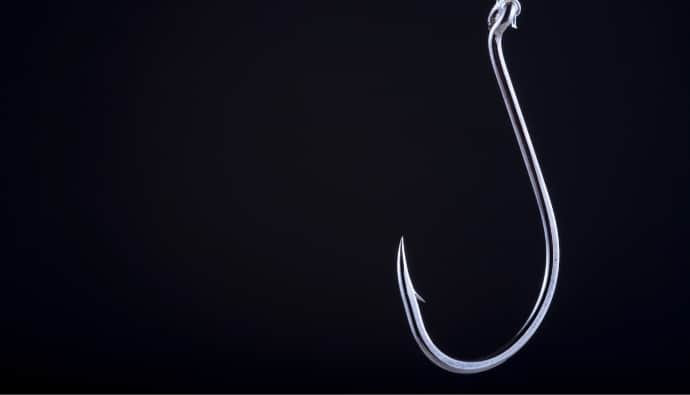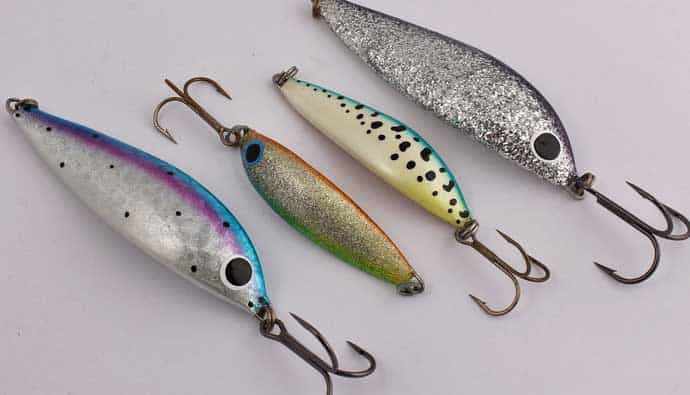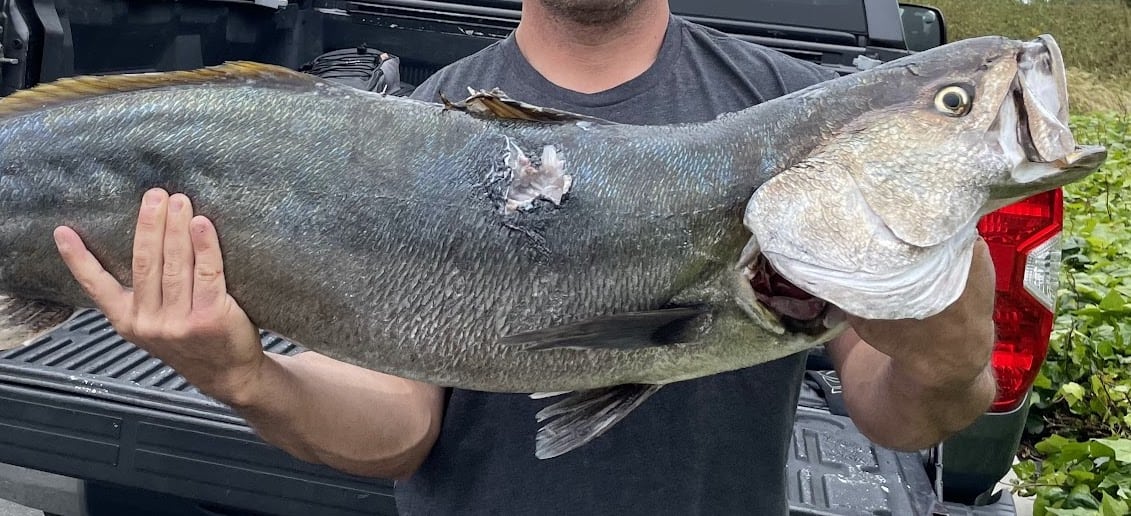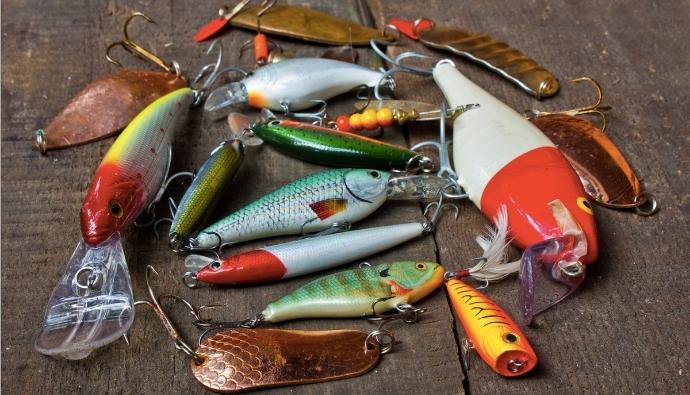As an angler, it is important to have a complete fishing tackle to make the best catch on your fishing trip.
One of the most important accessories to have in your tackle box is your bait. When it comes to quality baits, two baits that stand out are crankbait and jerkbait. Due to the popularity of these two baits, they are compared and even mistaken for one another.
In this article, we will discuss a comparison of jerkbait vs. crankbait.
Types of Bills
Bills are an important feature of both jerkbaits and crankbaits.
Bills are also known as lips and are responsible for the wiggle action and diving depth that a bait provides. Although both baits have bills, they have some differences in structure.
A crankbait bill is usually bigger than that of a jerkbait. The size of a jerkbait bill is just slightly larger than a fingernail, while a crankbait bill is longer and wider.
The types of bills that you can find on a jerkbait and crankbait are diamond-shaped bills, rounded bills, square bills, as well as no bills, also known as lipless baits. We will touch more on bills in other sections of this article.
Crankbait vs Jerkbait
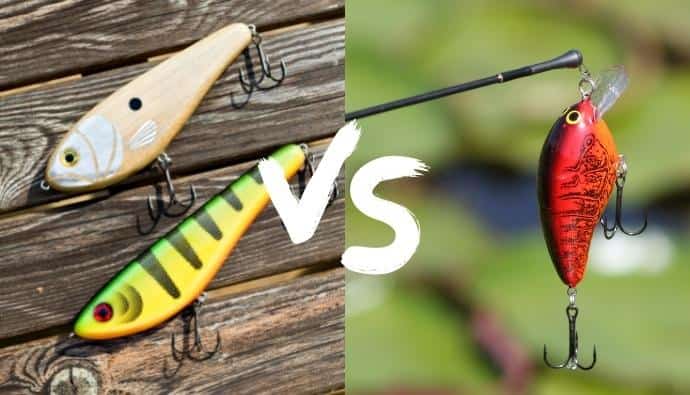
Crankbait and jerkbait are effective fishing baits that can be applied for different purposes. In this section, we will compare the two baits by examining their features and characteristics.
Variation & Types
Jerkbaits and crankbaits come in different variations. Each variation serves a different purpose for anglers.
There are three major types of jerkbaits which are suspending jerkbaits, floating jerkbaits, and sinking jerkbait.
- The design of a suspending jerkbait allows it to sit between the water surface and the bottom when it is cast. This jerkbait stays suspended in the spot where it is cast until you adjust it by jerking.
- A floating jerkbait is great for fishing in shallow waters, as they float on the water’s surface.
- Sinking jerkbaits are baits that sink once you cast them into the water.
Much like jerkbaits, crankbaits can be divided into three different types. These are shallow divers, medium divers, and deep divers.
- Shallow divers usually go up to 5 feet into the water. Most shallows divers have a square bill and are suitable for fishing in docks, low-level grass, and submerged wood.
- Medium divers usually go up to 10 feet into the water. Medium divers usually have bills and are suitable for fishing in lakes.
- Deep divers go beyond 10 feet into the water. They are best for fishing in deep waters.
Body Type
The body of a crankbait and jerkbait are very different in structure.
While crankbaits have a longer bill, it is jerkbaits that have a longer body. The body of a crankbait is usually fatter and shorter compared to a jerkbait.
A jerkbait typically has a slender and longer body. A crankbait usually comes with two treble hooks, while a jerkbait comes with three.
Design
To serve different fishing purposes, crankbaits and jerkbaits come in different shapes, colors, and sizes. They are also made from different materials with popular options, including plastic, metal, polymer, and wood. Both baits come with bills and treble hooks.
The bill of a crankbait is bigger than that of a jerkbait, while a jerkbait has a bigger body overall. Lipless crankbaits are great for fishing close to the water surface. Jerkbaits are designed to provide erratic action, which drives fish crazy.
Retrieval Depth
The retrieval depth is different depending on the bait that you are using.
Crankbaits offer more in terms of retrieval depth. This is because of the multiple options of bill sizes and shapes on offer. Jerkbaits, on the other hand, are limited to bill sizes that are less than half an inch.
As such, jerkbaits are best suited for shallow water like ponds and creeks, while crankbaits work for deeper water depths.
If you want something that is suitable for both shallow waters and deep waters, a lipless crankbait is your best bet. It reaches a shallow diving depth while providing the action of a regular crankbait.
Swimming Action
The swimming action of both types of baits are designed to resemble a baitfish. The aim of this design is to make the bait appear like a baitfish in distress, thereby encouraging game fish to bite.
Both jerkbaits and crankbaits provide a range of fishing actions that cut across subtle to aggressive movements. The actions of jerkbaits are darting, wiggling, moving side to side, swimming, and rolling. The actions of crankbaits are rolling, vibrating, wobbly movement, and slow swimming.
Operating Mechanism
You need a fishing rod to operate both crankbaits and jerkbaits. The function of the rod is to help you cast and retrieve your bait. If you are setting up a mechanism for this purpose, you can either use a rod and reel combo or simply use a baitcasting rod.
For operating a crankbait, you need a crankbait rod that is at least 7 feet long. For the best action, check a rod that bends at its tip. A fast retrieval action rod with medium power gives you all the strength needed to navigate the water column. In this case, you use a combo instead of a baitcasting rod to ensure that the reel has a smooth drag.
For a jerkbait, make use of a jerkbait rod that is between 5 to 6 feet long. Your rod should come with a fast retrieval action and medium power.
Casting Mechanism
The casting mechanisms for jerkbait and crankbait are different. For jerkbaits, you cast your bait before jerking your rod to take it to the desired water depth.
Crankbaits do not require a jerking motion. Rather you reel the bait to the desired water depth after casting.
Shallow Waters
Shallow waters like creeks and ponds are home to the best smallmouth and largemouth bass. However, you have to use the right bait in order to make a good catch.
For shallow water, jerkbait are best suited as they are close to the water surface when cast. A depth of 1 to 12 feet is the perfect territory for jerkbait. If you need to use a crankbait for fishing in shallow waters, then a lipless crankbait is a reliable option.
When the water temperature drops in early spring, fish-like bass become slower. Jerkbait is ideal for fishing during this period due to its erratic motion.
Deeper Waters
For deeper waters with a depth of 14 to 12 feet, crankbaits are better options than jerkbaits. In case you need to troll, a floating crankbait is your go-to bait. It will help you to cover a large surface of the water without exerting too much energy.
Weather Conditions
The weather condition during your fishing trip determines the best bait to use. The structure of jerkbaits with their long and slender bodies, makes them suited for the colder seasons. Using their slender bodies, they can move through the cold water by employing slashing action.
Crankbaits, with their small and round structure, are best suited for the warm weather of summer and early spring. It is also essential to add the water conditions so that each bait type is effective. While jerkbaits are reliable in clear water, crankbaits are the best option for fishing in muddy water.
Conclusion
Choosing between a crankbait and jerkbait is not a difficult task. You simply have to consider a few factors and decide on the fishing style to adopt. The color of your bait should complement the water condition. For clear water, you want a bait that is natural looking. Darker water, on the other hand, requires a bright bait for visibility. In conclusion, it is advisable to have multiple baits on your next fishing trip. These baits provide crucial functionalities.


 Facebook
Facebook YouTube
YouTube